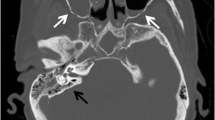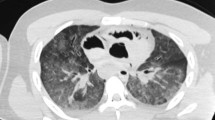Abstract
Background
In forensic autopsy, the analysis of stomach contents is important when investigating drowning cases. Three-layering of stomach contents may be interpreted as a diagnostic hint to drowning due to swallowing of larger amounts of water or other drowning media. The authors experienced frequent discrepancies of numbers of stomach content layering in drowning cases between post-mortem computed tomography (PMCT) and autopsy in forensic casework. Therefore, the goal of this study was to compare layering of stomach contents in drowning cases between PMCT and forensic autopsy.
Methods
Drowning cases (n = 55; 40 male, 15 female, mean age 45.3 years; mean amount of stomach content 223 ml) that received PMCT prior to forensic autopsy were retrospectively analyzed by a forensic pathologist and a radiologist. Number of layers of stomach content in PMCT were compared to number of layers at forensic autopsy.
Results
In 28 of the 55 evaluated drowning cases, a discrepancy between layering of stomach contents at autopsy compared to PMCT was observed: 1 layer at autopsy (n = 28): 50% discrepancy to PMCT, 2 layers (n = 20): 45% discrepancy, and 3 layers (n = 7): 71.4% discrepancy. Sensitivity of correctly determining layering (as observed at forensic autopsy) in PMCT was 52% (positive predictive value 44.8%). Specificity was 46.6% (negative predictive value 53.8%). In a control group (n = 35) of non-drowning cases, three-layering of stomach contents was not observed.
Conclusion
Discrepancies of observed numbers of stomach content layers between PMCT and forensic autopsy are a frequent finding possibly due to stomach content sampling technique at autopsy and movement of the corpse prior to PMCT and autopsy. Three-layering in PMCT, if indeed present, may be interpreted as a hint to drowning.


Similar content being viewed by others
Abbreviations
- FN:
-
False negative
- FP:
-
False positive
- HU:
-
Hounsfield unit
- kV:
-
Kilovolt
- ms:
-
Milliseconds
- NPV:
-
Negative predictive value
- PMCT:
-
Post-mortem computed tomography
- PMI:
-
Post-mortem interval
- PPV:
-
Positive predictive value
- TN:
-
True negative
- TP:
-
True positive
References
Lundström C, Persson A, Ross S, Ljung P, Lindholm S, Gyllensvärd F, Ynnerman A (2012) State-of-the-art of visualization in post-mortem imaging. APMIS 120(4):316–326
Flach PM, Thali MJ, Germerott T (2014) Times have changed! Forensic radiology—a new challenge for radiology and forensic pathology. AJR Am J Roentgenol 202(4):W325–W334
Madea B (2014) Drowning. In: Madea B (ed) Handbook of forensic medicine. Wiley Blackwell, West Sussex, pp 411–427
Dettmeyer RB, Verhoff MA, Drowning SHF (2014) Homicidal drowning. In: Forensic medicine, fundamentals and perspectives. Springer, Berlin Heidelberg, pp 245–260
Hayakawa A, Terazawa K, Matoba K, Horioka K, Fukunaga T (2017) Diagnosis of drowning: electrolytes and total protein in sphenoid sinus liquid. Forensic Sci Int 273:102–105
Lunetta P, Penttila A, Sajantila A (2002) Circumstances and macropathologic findings in 1590 consecutive cases of bodies found in water. Am J Forensic Med Pathol 23(4):371–376
Piette MH, De Letter EA (2006) Drowning: still a difficult autopsy diagnosis. Forensic Sci Int 163(1–2):1–9
Byard RW (2015) Immersion deaths and drowning: issues arising in the investigation of bodies recovered from water. Forensic Sci Med Pathol 11(3):323–325
Christe A, Aghayev E, Jackowski C, Thali MJ, Vock P (2008) Drowning—post-mortem imaging findings by computed tomography. Eur Radiol 18(2):283–290
Van Hoyweghen AJL, Jacobs W, Op de Beeck B, Parizel PM (2015) Can post-mortem CT reliably distinguish between drowning and non-drowning asphyxiation? Int J Legal Med 129:159–164
Raux C, Saval F, Rouge D et al (2014) Diagnosis of drowning using post-mortem computed tomography—state of the art. Arch Med Sadowej Kryminol 64:59–75
Kawasumi Y, Usui A, Sato Y, Sato Y, Daigaku N, Hosokai Y, Hayashizaki Y, Funayama M, Ishibashi T (2016) Distinction between saltwater drowning and freshwater drowning by assessment of sinus fluid on post-mortem computed tomography. Eur Radiol 26:1186–1190
Hyodoh H, Terashima R, Rokukawa M, Shimizu J, Okazaki S, Mizuo K, Watanabe S (2016) Experimental drowning lung images on postmortem CT—difference between sea water and fresh water. Leg Med (Tokyo) 19:11–15
Filograna L, Tartaglione T, Vetrugno G, Guerra C, Fileni A, Bonomo L (2015) Freshwater drowning in a child: a case study demonstrating the role of post-mortem computed tomography. Med Sci Law 55:304–311
Schober D, Schwendener N, Zech W-D, Jackowski C (2017) Post-mortem CT: Hounsfield unit profiles obtained in the lungs with respect to the cause of death assessment. Int J Legal Med 131:199–210
Vander Plaetsen S, De Letter E, Piette M et al (2015) Post-mortem evaluation of drowning with whole body CT. Forensic Sci Int 249:35–41
Usui A, Kawasumi Y, Funayama M, Saito H (2014) Postmortem lung features in drowning cases on computed tomography. Jpn J Radiol 32:414–420
Levy AD, Harcke HT, Getz JM, Mallak CT, Caruso JL, Pearse L, Frazier AA, Galvin JR (2007) Virtual autopsy: two- and three-dimensional multidetector CT findings in drowning with autopsy comparison. Radiology 243:862–868
Zech WD, Jackowski C, Schwendener N, Brencicova E, Schuster F, Lombardo P (2016) Postmortem CT versus forensic autopsy: frequent discrepancies of tracheobronchial content findings. Int J Legal Med 130(1):191–198
(2000) Recommendation no. R (99) 3 of the Committee of Ministers to member states on the harmonization of medico-legal autopsy rules. Forensic Sci Int 111(1–3):5–58
Acknowledgements
We would like to express our gratitude to our team of forensic pathologists and forensic technicians for their support with case handling.
Author information
Authors and Affiliations
Corresponding author
Rights and permissions
About this article
Cite this article
Gotsmy, W., Lombardo, P., Jackowski, C. et al. Layering of stomach contents in drowning cases in post-mortem computed tomography compared to forensic autopsy. Int J Legal Med 133, 181–188 (2019). https://doi.org/10.1007/s00414-018-1850-4
Received:
Accepted:
Published:
Issue Date:
DOI: https://doi.org/10.1007/s00414-018-1850-4




